Visit Spain, third stop: Úbeda
After our visit to Barcelona and Valencia, we continued westward to Úbeda, in the interior of Spain.
For us, thé perfect stop between Valencia and Granada.
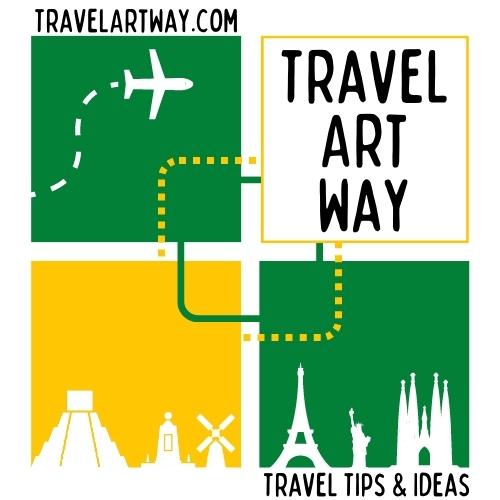
- Throughout this post you’ll find affiliated links & ads provided by marketing platforms like TravelPayOuts & GetYourGuide. Links & ads that may help you plan the perfect trip to Barcelona. If you click on them & buy a ticket for a museum or book a tour a small commission of your purchase will go to me (paid by the platform, without any extra cost to you).
- If you first want to learn a little bit more about me, the blog writer, click on: Better call me Art
Spain’s interior – On the road to Úbeda
It’s always fascinating to get to know the interior of a country. There where (almost) no tourist goes and life runs its own course.
After leaving Valencia and visiting the impressive medieval Castle of Xàtiva, we turned westward and noticed that soon the countryside transformed considerably. Little by little the industrial area around Valencia made way for the rolling hills of the interior. As well as the first of millions of olive trees that occupy those hills.
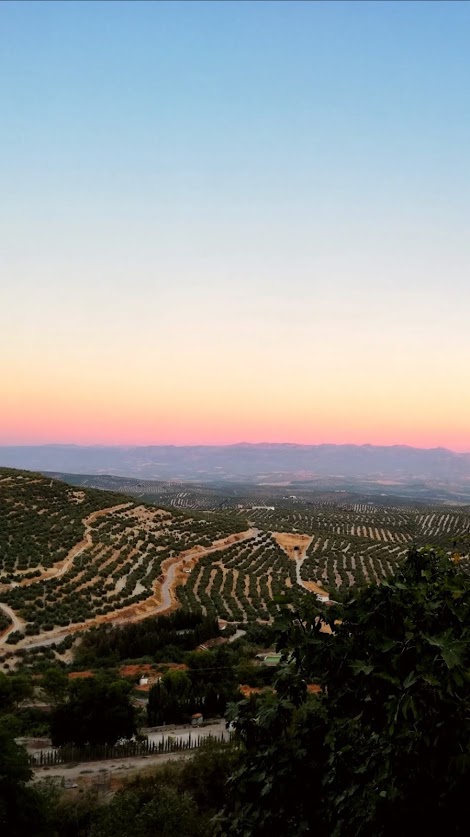
This part of Spain is mostly empty. That is, empty of human presence. Besides the olive industry, it’s pure nature. The highway makes its way through never ending fields, with ever higher mountains on the horizon.
From time to time you pass a little town or village, often still protected by a castle on a nearby hill top. Other times you pass an old windmill or a small abandoned finca or farm.

The farther you drive westwards, the more beautiful it gets. As well as, more mysterious. Colors and smells that make your mind wander off from time to time.
Well, not too much – because I was driving. In other words, my eyes were mostly fixed on the road. However, I have to say that the interior roads in these parts of Spain are easy going and even as a driver I got a good impression of the beauty of the Spanish countryside.
A visit to Úbeda, our first stop in Andalusia
Our next stop was Úbeda, a small town in the province of Jaén.
- Jaén is one of the eight provinces that form the autonomous community of Andalusia.
We mainly chose to visit Úbeda because we wanted to make an extra stop between Valencia and Granada, but also of Úbeda’s glorious past. Well, it’s still glorious, but nowadays more so as a tourist destination.

Historical Intermezzo: Islamic occupation
In 711 started the Islamic invasion of Spain from North Africa. In a relatively short time the muslims occupied the whole peninsula – including nowadays Portugal & a part of Southern France.
Although the Iberians resisted the invasion from the start and soon would reconquer the northern provinces, the Islamic presence would continue until 1492. In that year the most famous royal couple of Spain – Ferdinand of Aragon & Isabella of Castile – would reconquer the last muslim stronghold in the south, Granada.

Logically the influence of the long lasting muslim occupation in Spain was significant. Although the muslims were generally very tolerant to other religions and cultures, you can still feel their presence today. Mostly in the South, in the part the muslims baptised El-Andalus, nowadays Andalusia. You notice this influence first of all in the architecture, as well as in the food and certain traditions which survived the ages.
Úbeda: A border town
Úbeda was one of the first southern cities that was reconquered. After some earlier attempts, the Castilians liberated the city definitively in 1233. Long time it was a border town between the Christian and Muslim world.
Because of that position some noblemen of Úbeda occupied important positions at the royal court. Positions that not only resulted in power & money, but also in a clear identification of Úbeda as a Christian bulwark against the muslims.
After the reconquest the town grew in importance rapidly. In the 16th century it reached its Golden Age, when the richest families started building their own palaces & churches. It is these historical buildings that today form the main attraction of the old city center of Úbeda.
Impressive monuments, highly influenced by the Renaissance period that started in Italy.
Contrary to other cities of Andalusia – like Granada, Córdoba and Sevilla – you don’t find many Islamic traces in these monuments.
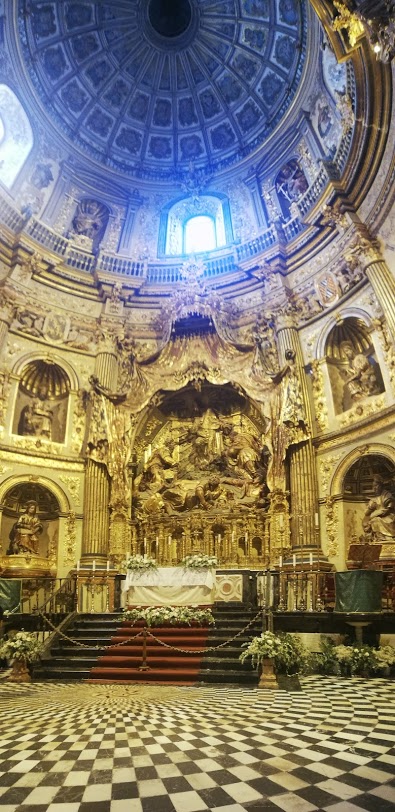
Notwithstanding this “golden” period, Úbeda didn’t grow out to be one of the bigger cities of Spain. Nowadays, it only has around 35 000 inhabitants.
One of the reasons for the stagnation in growth was that Úbeda lost its border town position after the Castilians reconquered the rest of Andalusia.
Besides that, the town was always tormented by rivalries between the most important families & their relation, or not, to the royal family. Finally, like every other place in the world, the town depended on where trade was flowing and the economy was heading.
Úbeda: a World Heritage attraction
In 2003 UNESCO named Úbeda a World Heritage Site – together with the neighbouring town of Baeza.
Justly so, because the city center of Úbeda is really worth a visit, medieval in almost every aspect. You get that sense almost constantly, but more so when you walk the streets at night and are lucky enough to be the only tourist around.
- Strange thing, isn’t it…tourism? Promoting the most beautiful places and giving tips for things to do, while sometimes wanting to be the only one present when you’re there.
TRAVELTip: Getting Around in Úbeda
Get the rhythm. Because you’re in medieval times, you have to change gear. Úbeda feels like an open air museum, there’s a lot to see and visit, but walking the streets is part of it.
That also means, avoid driving your car through the old center. Some parts are luckily closed to traffic anyway, but other streets are open. I only had the drive in, because of the hotel & parking, but that was it.
An experience in itself, by the way, because in some places the streets get so narrow, we had to fold in the side mirrors to get in and out of town. That’s like saying: “You don’t belong here, …better buy yourself a horse.”.
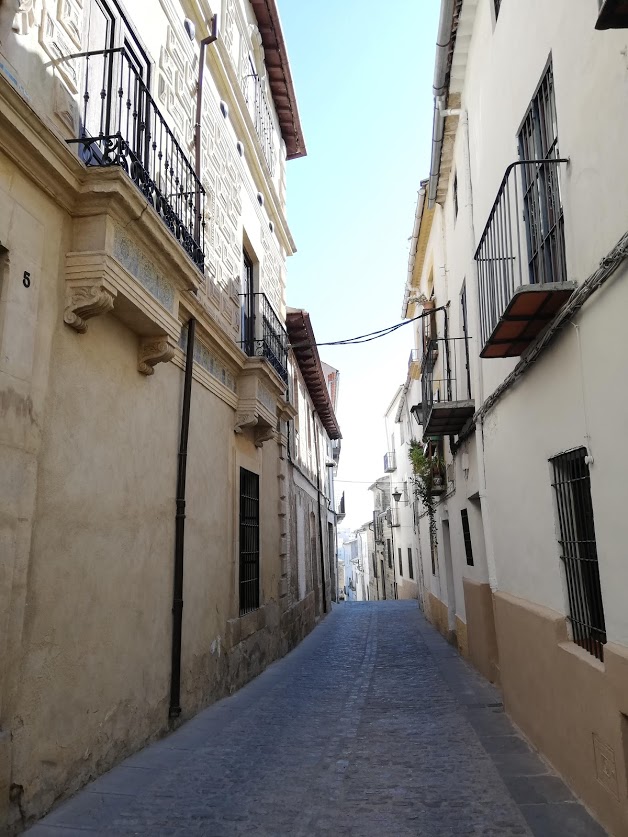
.
TIP: Where to stay?
If you plan to stay in Úbeda, I would recommend you to find a place in the old town. There are different options and prices are reasonable. We found ourselves a beautiful hotel in a former “casona”/mansion (16th century) and although I didn’t really plan to name specific places to stay and/or eat, I think this place deserves the mention: Apartamentos Turistícos El Losal.
Our room – and I think all the rooms in this hotel – had its own kitchenette. As the hotel doesn’t provide breakfast, a great way to prepare your own with local products. The hotel has a beautiful garden & a small pool.
We met the owner/administrator only during check-in, but he was very helpful. He gave us many useful tips of what to do in & around Úbeda. Also, he told us where to eat & more importantly, where NOT to eat. At the end of this warm welcome, he even gave us a little tour of the old wine cellar underneath this beautiful hotel.
A great place, a perfect location. Highly recommended.
To learn more, go to: Apartamentos Turistícos El Losal.

Úbeda : A Renaissance City
Úbeda in itself is an open air museum. Nevertheless, several monuments are open to the public. During weekdays, you can visit the municipality, which was the former palace of one Úbeda’s most famous nobleman.
Every day you can visit the main churches of Úbeda. Like the Sacra Capilla del Salvador/ Sacred Chapel of the Saviour. This church was built in the “golden” 16th century – like most monuments and the hotel we stayed in.

Another beautiful old church is the Basílica de Santa María de los Reales Alcázares. In contrast to the Sacra Capilla in this church you’ll find a mixture of architectural styles. Mainly because it’s an older construction, built over the remains of a mosque. Besides European styles like gothic, romanesque and renaissance, there’s still a islamic influence palpable.
Day trip: A visit to Baeza
From Úbeda we made a day trip – actually Half-a-Day-trip – to the nearby town of Baeza (only 8 kilometers/ 5 miles away).
Baeza’s past in many ways runs parallel to that of Úbeda. Although it was reconquered a few years earlier than the bigger neighbour, namely in 1227. From then on, they grew up together and went through the same highs & lows.
Baeza, as Úbeda, had its Golden Age around the 16th century. Responsible for the main Renaissance monuments the city center.
We visited the Catedral de la Natividad de Nuestra Señora, which was as impressive as the churches we visited in Úbeda. Although also built over a mosque, the church was completely reconstructed in the 16th century, and the few islamic remains are almost hidden from sight ever since.

Visit to the Sinagoga del Agua, Úbeda
Back in Úbeda, in the evening we visited the Sinagoga del Agua. The synagogue was only recently discovered, when a local builder was renovating the house on top. The public spaces and probable living quarters of the rabbi occupy the first floor and the basement.
There are 4 guided tours a day. We visited the last one in the evening and were impressed. Not only by the construction, but more so by the atmosphere. The tour takes between 30 and 45 minutes and costs only a few euros.
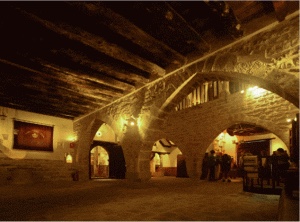
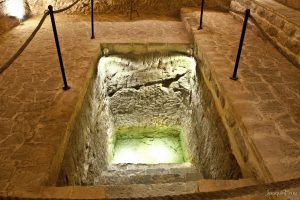
TRAVELTip: Discount with Student card
If you have one, bring your student card. Even our daughter – who’s studying in Quito, Ecuador – got discounts on tickets everywhere in Spain. Entrances to museums, monuments, churches & other attractions.
TRAVELTip: Eating out in Úbeda
The owner of the hotel (see above) had some useful tips where to eat… and where not. He warned us about some restaurants, where they still treat foreigners as stupid tourists. That means charging too much and providing bad service. I forgot their names, mainly because we – obviously – didn’t visit them!
Finally, we ended up at two places on the main square. Both good places to eat & drink something.
The second night was the most memorable though, because we ended up as birthday guests of the restaurant’s owner. While attending random visitors at his place, he received friends and family. Finally, he got so tipsy that he wouldn’t/couldn’t distinguish anymore between his intimate friends and others. That’s when we learned that his name was “Juan”, but also that he was born in Romania, exactly 38 years ago. Fun!
It would be a good joke if he celebrates his birthday every day of the year, but I wouldn’t be surprised. Anyhow, we had a great time, good food and became pleasantly drunk ourselves in the end.
TRAVELTip: Shopping in Úbeda/Baeza:
Every town or village in Spain has its own specific products. When visiting Úbeda or Baeza it can’t be a big surprise to find an ample variety of olive oil products.
Another speciality of the area though are ceramics, of which there are several good shops in both places. The real deal! Beautiful, handmade ceramics.
A special place in Úbeda I will mention is Alfareria Tito. Generally it’s the artist himself that salutes you at the entrance. After that, lose yourself in years of artful produce. A museum of a shop really

To put our visit to Úbeda in a few words:
Before we traveled to Spain, we decided on a shortstop (2 nights) between Valencia and Granada. Basically to interrupt a long journey, but also to get to know a little more of Spain’s interior. It was our daughter Lisa who found Úbeda. A perfect choice!
The next time we will surely stay a few days longer & use it as a base to get to know more of the surrounding area. Ending up every night in Úbeda, walking its mysterious medieval streets after the sun goes down.
This time we simply had to go on. To get to know more of Andalusia, Granada & Sevilla.
For an overview of all travel posts of my blog, go to: My Home Page.
